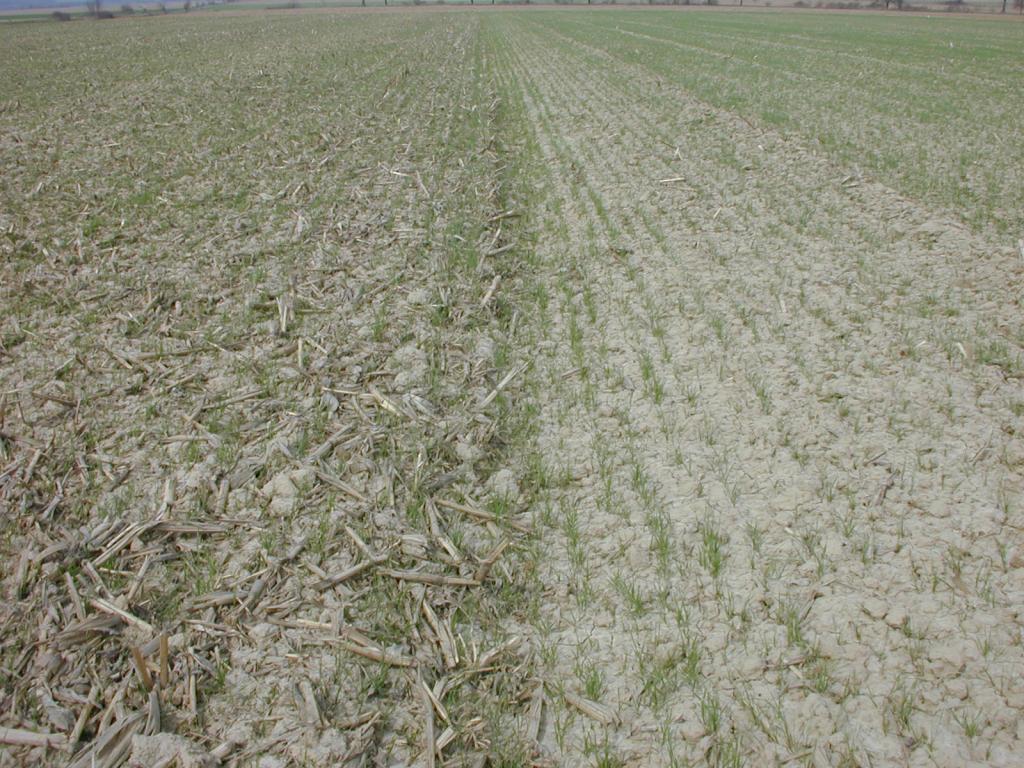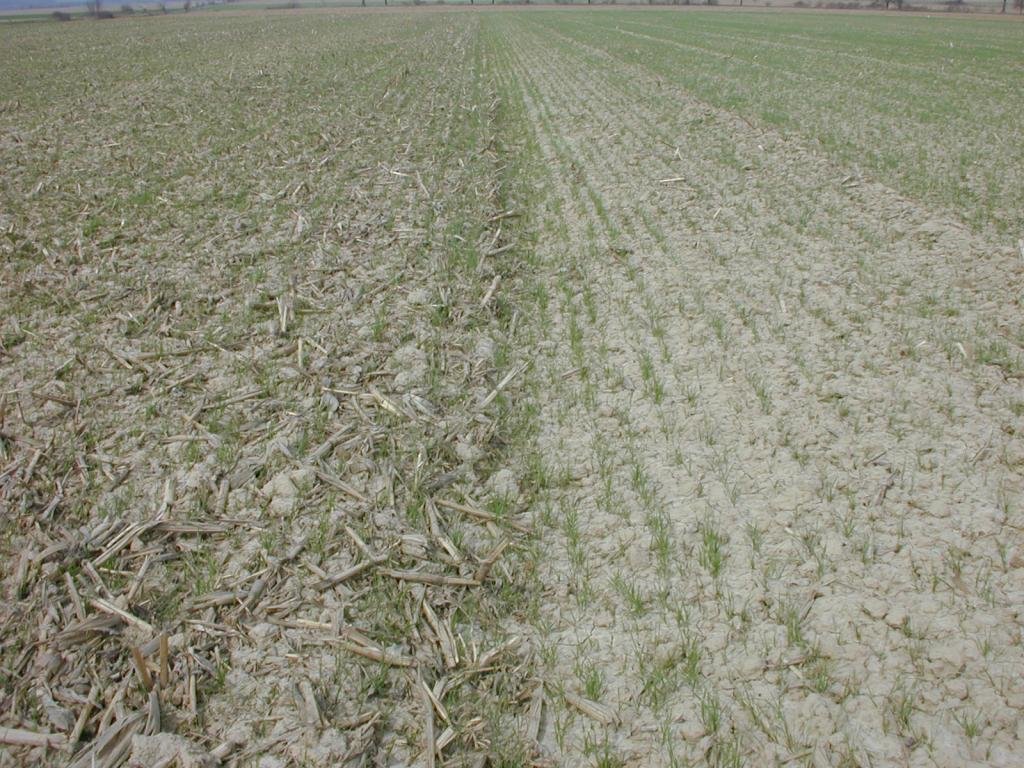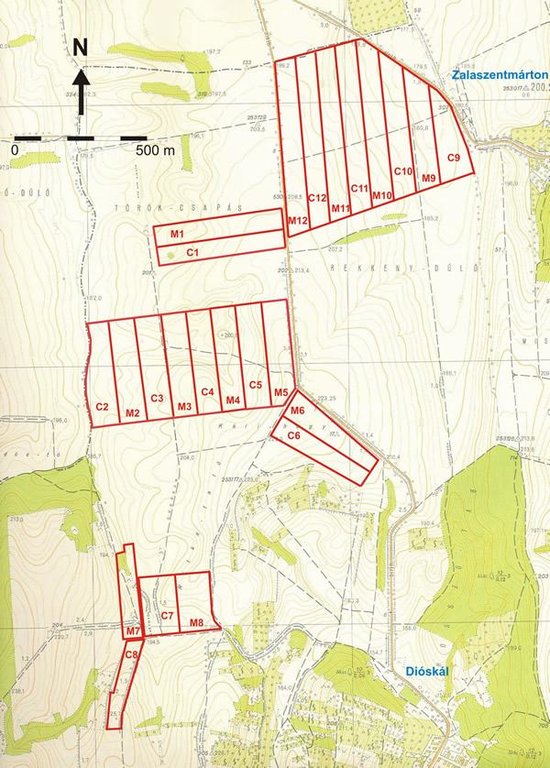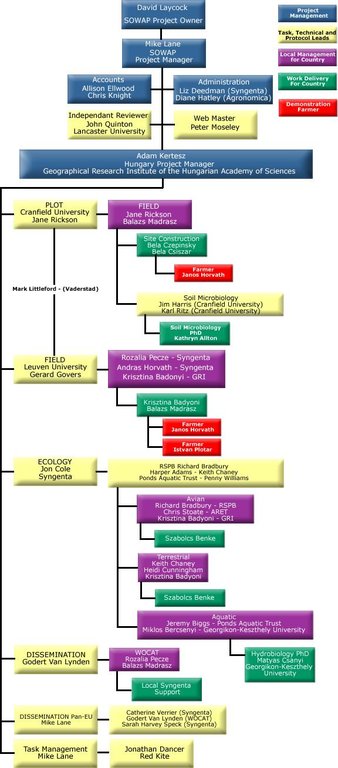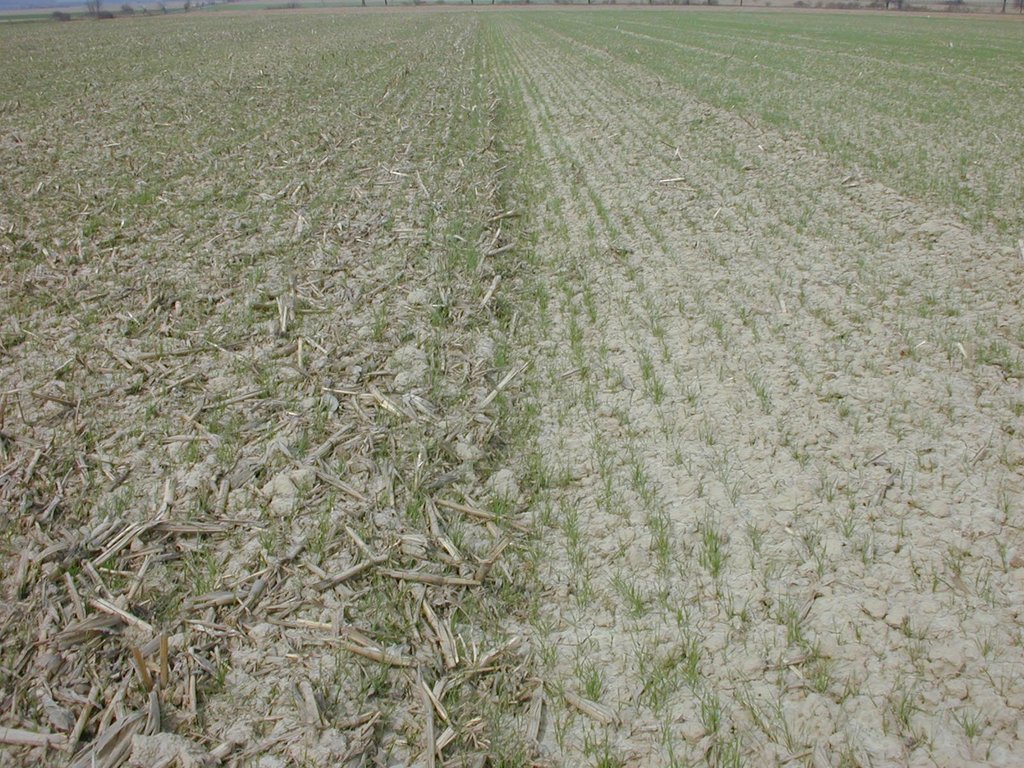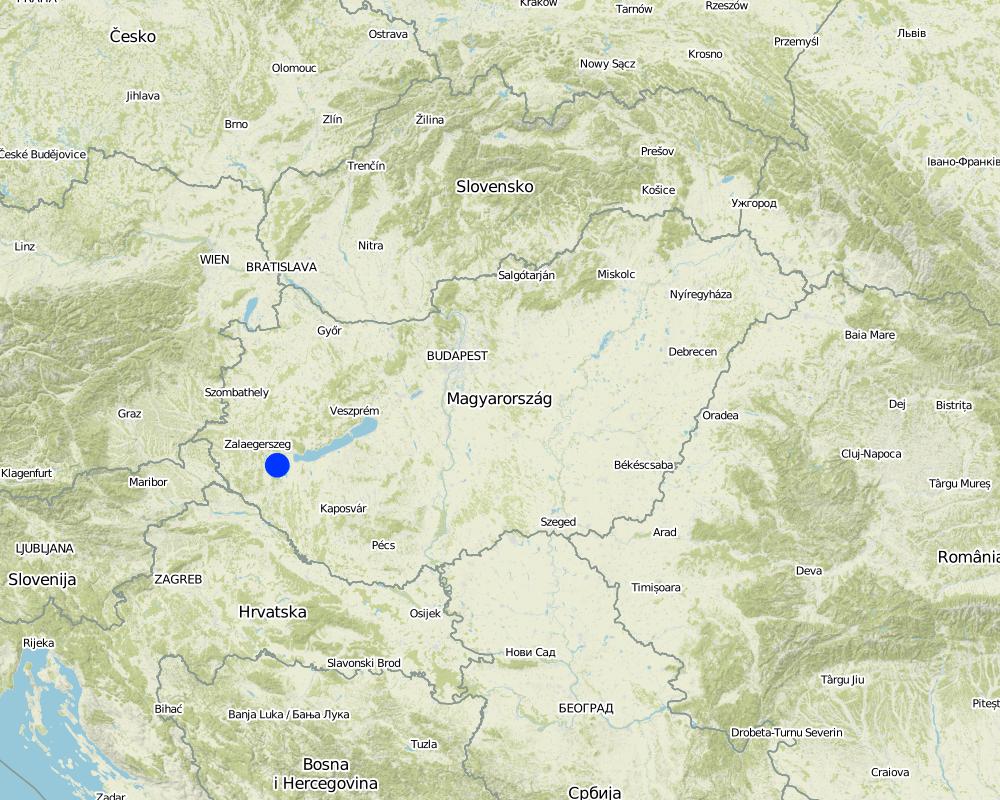Conservation tillage [ຮັນກາຣີ]
- ການສ້າງ:
- ປັບປູງ:
- ຜູ້ສັງລວມຂໍ້ມູນ: Adam Kertesz
- ບັນນາທິການ: –
- ຜູ້ທົບທວນຄືນ: Fabian Ottiger
approaches_2552 - ຮັນກາຣີ
ເບິ່ງພາກສ່ວນ
ຂະຫຍາຍທັງໝົດ ຍຸບທັງໝົດ1. ຂໍ້ມູນທົ່ວໄປ
1.2 ລາຍລະອຽດ ການຕິດຕໍ່ ຂອງບຸກຄົນທີ່ຊັບພະຍາກອນ ແລະ ສະຖາບັນ ການມີສ່ວນຮ່ວມ ໃນການປະເມີນຜົນ ແລະ ເອກະສານ ຂອງວິທີທາງ
ຜູ້ຊ່ຽວຊານ ດ້ານການຄຸ້ມຄອງ ທີ່ດິນແບບຍືນຍົງ:
ຊື່ຂອງ ສະຖາບັນການຈັດຕັ້ງ ທີ່ອໍານວຍຄວາມສະດວກ ໃນການສ້າງເອກກະສານ ຫຼື ປະເມີນແນວທາງ (ຖ້າກ່ຽວຂ້ອງ)
Geographical Research Institute, Hungarian Academy of Sciences (MTA CSFK) - ຮັນກາຣີ1.3 ເງື່ອນໄຂ ຂອງການນໍາໃຊ້ເອກກະສານຂໍ້ມູນ ຂອງ WOCAT
ຜູ້ສັງລວມ ແລະ ບັນດາຜູ້ຕອບແບບສອບຖາມ ຍອມຮັບໃນເງື່ອນໄຂ ການນໍາໃຊ້ຂໍ້ມູນເອກະສານ ທີ່ສ້າງຂື້ນ ໂດຍຜ່ານ ອົງການ WOCAT:
ແມ່ນ
1.4 ເອກະສານອ້າງອີງ (ຫຼາຍ) ກັບແບບສອບຖາມ (ຫຼາຍ) ເຕັກໂນໂລຢີ ຂອງດ້ານການຄຸ້ມຄອງ ດິນແບບຍືນຍົງ

Controlled traffic farming [ຮັນກາຣີ]
All machinery traffic uses the same lane network within the field to reduce the total compacted area, to improve connections, and to optimise overlapping of following runs resulting in more efficient use of labour and inputs. Risks from environmental pollution are also reduced.
- ຜູ້ສັງລວມຂໍ້ມູນ: Brigitta Szabó

Conservation tillage [ຮັນກາຣີ]
The aim of conservation tillage is to reduce the soil disturbance. It decreases decomposition of organic matter, enhances cycling of nutrients, soil structure and increases water infiltration.
- ຜູ້ສັງລວມຂໍ້ມູນ: Brigitta Toth
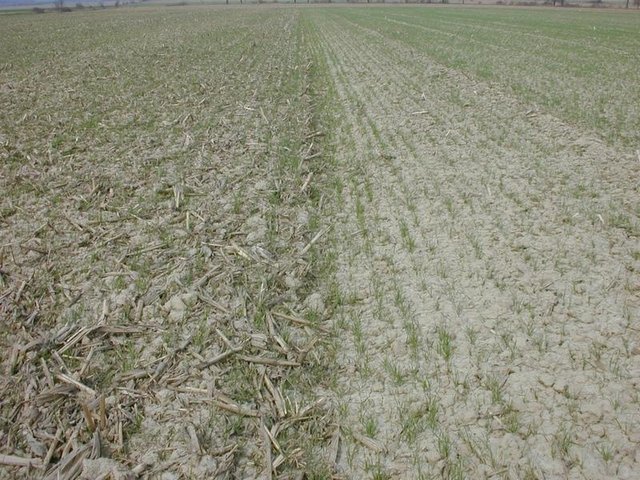
Conservation tillage [ຮັນກາຣີ]
Non inversion, conservation (soil and water protective) tillage.
- ຜູ້ສັງລວມຂໍ້ມູນ: Ádám Kertész
2. ພັນລະນາ ແນວທາງການຄຸ້ມຄອງນໍາໃຊ້ດິນແບບຍືນຍົງ
2.1 ການອະທິບາຍ ໂດຍຫຍໍ້ ຂອງວິທີທາງ
Non inversion, conservation (soil and water protective) tillage.
2.2 ການອະທິບາຍ ລາຍລະອຽດ ຂອງວິທີທາງ
ການອະທິບາຍ ລາຍລະອຽດ ຂອງວິທີທາງ:
Aims / objectives: Purpose: Finding and Demonstrating Ways of Better Managing the Land. SOWAP (SOil and WAter Protection) aims to assess the viability of a more 'conservation-oriented' agriculture, where fewer tillage practices replace the numerous cultivations carried out under more 'conventional' arable farming systems. The use of appropriate chemicals is tested, and their potential for off-site contamination assessed, to ensure that any suggested approaches are environmentally sound. Conventional tillage is an environment friendly method, carried out by shallow tillage (with disks and direct drill) and omission of ploughing (non-inversion).
Stages of implementation: Shallow disking, direct drill, environment friendly plant-protecting materials.
2.3 ຮູບພາບຂອງແນວທາງ
2.5 ປະເທດ / ເຂດ / ສະຖານທີ່ບ່ອນທີ່ແນວທາງໄດ້ຖືກນໍາໃຊ້
ປະເທດ:
ຮັນກາຣີ
ພາກພື້ນ / ລັດ / ແຂວງ:
Zala county
Map
×2.6 ວັນທີເລີ່ມຕົ້ນ ແລະ ສິ້ນສຸດ ການຈັດຕັ້ງປະຕີບັດ ວິທີທາງ
ສະແດງປີຂອງການເລີ່ມຕົ້ນ:
2003
2.7 ປະເພດຂອງແນວທາງ
- ພາຍໃຕ້ໂຄງການ / ແຜນງານ
2.8 ເປົ້າໝາຍ / ຈຸດປະສົງຫຼັກ ຂອງການຈັດຕັ້ງປະຕິບັດ ວິທີທາງ
The Approach focused mainly on SLM with other activities (ecology, economics, EU and national rules and regulations)
Soil and water protection (soil loss reduction), biodiversity enhancement, Finding and Demonstrating Ways of Better Managing the Land., Finding an environment friendly technology.
The SLM Approach addressed the following problems: deffence against soil compaction
2.9 ເງື່ອນໄຂອໍານວຍ ຫຼື ຂັດຂວາງການປະຕິບັດຂອງເຕັກໂນໂລຢີ / ເຕັກໂນໂລຢີການນໍາໃຊ້ຕາມແນວທາງ
ມີຄວາມສາມາດ / ເຂັ້າເຖິງຊັບພະຍາກອນດ້ານການເງິນ ແລະ ການບໍລິການ
- ເຊື່ອງຊ້ອນ
purchase new machines
Treatment through the SLM Approach: It is easier to get financial support if you apply modern technologies
ກ່ຽວກັບກົດໝາຍ (ສິດນໍາໃຊ້ດິນ, ສິດນໍາໃຊ້ນໍ້າ)
- ອໍານວຍ
The existing land ownership, land use rights / water rights moderately helped the approach implementation
3. ການມີສ່ວນຮ່ວມ ແລະ ບົດບາດຂອງພາກສ່ວນທີ່ກ່ຽວຂ້ອງທີ່ໄດ້ມີສ່ວນຮ່ວມ
3.1 ຜູ້ມີສ່ວນຮ່ວມ ໃນວິທີທາງ ແລະ ພາລະບົດບາດ ຂອງເຂົາເຈົ້າ
- ຜູ້ນໍາໃຊ້ດິນໃນທ້ອງຖິ່ນ / ຊຸມຊົນທ້ອງຖິ່ນ
Working land users were work equally divided between men and women (1 family (3 persons))
- ຜູ້ຊ່ຽວຊານ ການນຄຸ້ມຄອງ ທີ່ດິນແບບຍືນຍົງ / ທີ່ປຶກສາດ້ານກະສິກໍາ
Reserach Institute
- ພະນັກງານຂັ້ນສູນກາງ (ຜູ້ວາງແຜນ, ຜູ້ສ້າງນະໂຍບາຍ)
- ອົງການຈັດຕັ້ງ ສາກົນ
- The SOWAP project
3.2 ການມີສ່ວນຮ່ວມຂອງຜູ້ນໍາໃຊ້ທີ່ດິນໃນທ້ອງຖິ່ນ / ຊຸມຊົນທ້ອງຖິ່ນໃນໄລຍະທີ່ແຕກຕ່າງກັນຂອງແນວທາງ
| ການລວບລວມ ເອົາຜູ້ນໍາໃຊ້ດິນ ໃນທ້ອງຖິ່ນ / ຊຸມຊົນທ້ອງຖິ່ນ | ໃຫ້ລະບຸ ຜູ້ໃດທີ່ມີສ່ວນຮ່ວມ ໃນແຕ່ລະກິດຈະກໍາ? | |
|---|---|---|
| ການເລີ່ມຕົ້ນ / ແຮງຈູງໃຈ | ການບໍ່ປະຕິບັດ | Mainly:rapid/participatory rural appraisal; partly: public meetings; 1 family was choosen (on the basis of suitable land size, machines etc.) |
| ການວາງແຜນ | ການຮ່ວມມື | workshops/seminars |
| ການປະຕິບັດ | ການຮ່ວມມື | responsibility for major steps |
| ຕິດຕາມກວດກາ / ການປະເມີນຜົນ | ການບໍ່ປະຕິບັດ | interviews/questionnaires; |
| Research | ບໍ່ມີ |
3.4 ການຕັດສິນໃຈກ່ຽວກັບການຄັດເລືອກເຕັກໂນໂລຢີຂອງການຄຸ້ມຄອງທີ່ດິນແບບຍືນຍົງ / ເຕັກໂນໂລຢີ
ລະບຸ ຄົນທີ່ຕັດສິນໃຈ ກ່ຽວກັບການຄັດເລືອກຂອງ ເຕັກໂນໂລຢີ / ເຕັກໂນໂລຢີ ຈະໄດ້ຮັບການປະຕິບັດ:
- ຜູ້ຊ່ຽວຊານ ຫຼັກດ້ານການຄຸ້ມຄອງ ທີ່ດິນແບບຍືນຍົງ, ມີການຕິດຕາມປຶກສາຫາລືກັບຜູ້ນໍາໃຊ້ທີ່ດິນ
ອະທິບາຍ:
Decisions on the method of implementing the SLM Technology were made by mainly by SLM specialists with consultation of land users
4. ການສະໜັບສະໜູນທາງດ້ານວິຊາການ, ການສ້າງຄວາມສາມາດ, ແລະ ການຈັດການຄວາມຮູ້.
4.1 ການສ້າງຄວາມສາມາດ / ການຝຶກອົບຮົມ
ຜູ້ນໍາໃຊ້ທີ່ດິນ ຫຼື ພາກສ່ວນກ່ຽວຂ້ອງອື່ນໆ ໄດ້ຮັບການຝຶກອົບຮົມບໍ່?
ແມ່ນ
ໃຫ້ລະບຸ ຜູ້ໃດທີ່ໄດ້ຮັບການຝຶກອົບຮົມ:
- ຜູ້ນໍາໃຊ້ດິນ
- SWC specialists, politicians/decision makers
ຮູບແບບຂອງການຝຶກອົບຮົມ:
- ການເຮັດຕົວຈິງ
- ຕົວຕໍ່ຕົວ
- ກອງປະຊຸມ
ໃນຫົວຂໍ້:
methods of conservation tillage, conservation tillage in UK
4.2 ການບໍລິການໃຫ້ຄໍາປຶກສາ
ເຮັດຜູ້ໃຊ້ທີ່ດິນມີການເຂົ້າເຖິງການບໍລິການໃຫ້ຄໍາປຶກສາ?
ແມ່ນ
ອະທິບາຍ / ຄວາມຄິດເຫັນ:
Name of method used for advisory service: Conservation tillage (Soil and Water Protection); 1) Advisory service was carried out through: projects own extension structure and agents; Extension staff: members f the SOWAP project 2) Target groups for extension: land users; Activities: field visit and meetings
Advisory service is quite adequate to ensure the continuation of land conservation activities
4.3 ສະຖາບັນການສ້າງຄວາມເຂັ້ມແຂງ (ການພັດທະນາອົງການຈັດຕັ້ງ)
ສະຖາບັນ ໄດ້ຮັບການສ້າງຕັ້ງຂື້ນ ຫຼື ໄດ້ຮັບການສ້າງຄວາມເຂັ້ມແຂງ ໂດຍການຈັດຕັ້ງປະຕິບັດ ວິທີທາງບໍ່?
- ບໍ່ມີ
4.4 ຕິດຕາມກວດກາ ແລະ ປະເມີນຜົນ
ການຈັດຕັ້ງປະຕິບັດ ວິທີທາງ ໄດ້ມີການປະເມີນຜົນ ແລະ ຕິດຕາມບໍ?
ແມ່ນ
ຄວາມຄິດເຫັນ:
bio-physical aspects were regular monitored through measurements
technical aspects were regular monitored through measurements
economic / production aspects were regular monitored through measurements
no. of land users involved aspects were regular monitored through observations
management of Approach aspects were regular monitored through observations
There were few changes in the Approach as a result of monitoring and evaluation: If the soil is very compact the direct drilling is impossible therfore preliminary disking is necessary.
4.5 ການຄົ້ນຄວ້າ
ນີ້້ແມ່ນສ່ວນໜຶ່ງ ການຄົ້ນຄວ້າ ຂອງວິທີທາງບໍ່?
ແມ່ນ
ໃຫ້ຂໍ້ມູນ ເພີ່ມເຕີມ ແລະ ກໍານົດ ຜູ້ໃດເຮັດການຄົ້ນຄວ້າ:
Nevertheless this project includes natural and socio-economic aspects.
Research was carried out both on station and on-farm
5. ການສະໜັບສະໜູນທາງດ້ານການເງິນ ແລະ ອຸປະກອນຈາກພາຍນອກ
5.1 ງົບປະມານປະຈໍາປີ ສໍາລັບວິທີທາງ ຂອງການຄຸ້ມຄອງ ທີ່ດິນແບບຍືນຍົງ
ຄໍາເຫັນ (ຕົວຢ່າງ: ແຫຼ່ງຂໍ້ມູນຫຼັກ ຂອງການສະໜອງທຶນ / ຜູ້ໃຫ້ທຶນທີ່ສໍາຄັນ):
Approach costs were met by the following donors: international (EU-Life foundation): 50.0%; international non-government (Syngenta Ltd.): 50.0%
5.2 ການສະໜັບສະໜູນ ທາງດ້ານການເງິນ / ອຸປະກອນ ສະໜອງໃຫ້ແກ່ຜູ້ນໍາທີ່ດິນ
ຜູ້ນໍາໃຊ້ດິນ ໄດ້ຮັບການສະໜັບສະໜູນ ທາງດ້ານ ການເງິນ / ອຸປະກອນ ໃນການຈັດຕັ້ງປະຕິບັດ ເຕັກໂນໂລຢີບໍ?
ແມ່ນ
5.3 ເງິນສົມທົບສໍາລັບການນໍາໃຊ້ສະເພາະປັດໃຈຂາເຂົ້າໃນການຜະລີດກະສິກໍາ (ລວມທັງແຮງງານ)
- ອຸປະກອນ
| ໃຫ້ລະບຸໄດ້ຮັບການສະໜັບສະໜູນປັດໃຈຂາເຂົ້າຫຍັງແດ່ | ທີ່ຂອບເຂດ | ລະບຸ ການອຸດໜູນ |
|---|---|---|
| ເຄື່ອງກົນຈັກ | ງົບປະມານບາງສ່ວນ | |
| ເຄື່ອງມື | ງົບປະມານບາງສ່ວນ | |
- ກະສິກໍາ
| ໃຫ້ລະບຸໄດ້ຮັບການສະໜັບສະໜູນປັດໃຈຂາເຂົ້າຫຍັງແດ່ | ທີ່ຂອບເຂດ | ລະບຸ ການອຸດໜູນ |
|---|---|---|
| ແນວພັນ, ແກ່ນພັນ | ງົບປະມານບາງສ່ວນ | |
| ຝຸ່ນ, ປຸ໋ຍ | ງົບປະມານບາງສ່ວນ | |
| Biocides | ງົບປະມານບາງສ່ວນ | |
ຖ້າແຮງງານ ຂອງຜູ້ນໍາໃຊ້ດິນ ໄດ້ຮັບການສະໜັບສະໜູນ ປັດໃຈຂາເຂົ້າ, ແມ່ນບໍ່:
- ຈ່າຍເປັນເງິນສົດ
5.4 ສິນເຊື່ອ
ໄດ້ປ່ອຍສິນເຊື່ອ ສະໜອງໃຫ້ພາຍໃຕ້ ວິທີການສໍາລັບກິດຈະກໍາ ການຄຸ້ມຄອງ ທີ່ດິນແບບຍືນນຍົງບໍ່?
ບໍ່ແມ່ນ
6. ວິເຄາະຜົນກະທົບ ແລະ ສັງລວມບັນຫາ
6.1 ຜົນກະທົບຂອງແນວທາງ
ການຈັດຕັ້ງປະຕິບັດ ວິທີທາງ ສາມາດຊ່ວຍຜູ້ນໍາໃຊ້ທີ່ດິນ ໃນການຈັດຕັ້ງປະຕິບັດ ແລະ ບໍາລຸງຮັກສາ ເຕັກໂນໂລຢີ ການຄຸ້ມຄອງ ທີ່ດິນແບບຍືນຍົງໄດ້ບໍ?
- ບໍ່
- ມີ, ໜ້ອຍໜຶ່ງ
- ມີ, ພໍສົມຄວນ
- ມີ, ຫຼາຍ
demonstrations, meetings, articles, publications, TV films.
Did other land users / projects adopt the Approach?
- ບໍ່
- ມີ, ໜ້ອຍໜຶ່ງ
- ມີ, ພໍສົມຄວນ
- ມີ, ຫຼາຍ
A couple of land users keep trying this method because it reduces theire costs.
6.3 ຄວາມຍືນຍົງຂອງກິດຈະກໍາວິທີທາງ
ຜູ້ນໍາໃຊ້ ທີ່ດິນ ສາມາດສືບຕໍ່ ການຈັດຕັ້ງປະຕິບັດ ຜ່ານວິທີທາງໄດ້ບໍ່ (ໂດຍປາດສະຈາກ ການຊ່ວຍເຫຼືອ ຈາກພາກສ່ວນພາຍນອກ)?
- ແມ່ນ
6.4 ຈຸດແຂງ / ຂໍ້ດີ ຂອງວິທີທາງ
| ຈຸດແຂງ / ຂໍ້ດີ / ໂອກາດໃນການນໍາໃຊ້ທີ່ດິນ |
|---|
| future subsidy expectations and better chance for competition |
| soil loss reduction |
| economicalness |
| environmental consciousness agriculture |
| ຈຸດແຂງ / ຈຸດດີ / ໂອກາດ ຈາກທັດສະນະຂອງຜູ້ປ້ອນຂໍ້ມູນ ຫຼື ບຸກຄົນສຳຄັນ |
|---|
| soil loss reduction |
| biodiversity enhancement |
| spreading of environmental conscious agriculture |
| soil and water protection |
| economicalness |
6.5 ຈຸດອ່ອນ / ຂໍ້ເສຍຂອງແນວທາງ ແລະ ວິທີການແກ້ໄຂໃຫ້ເຂົາເຈົ້າ
| ຈຸດອ່ອນ / ຂໍ້ເສຍ / ຄວາມສ່ຽງໃນມູມມອງຂອງຜູ້ນໍາໃຊ້ທີ່ດິນ | ມີວິທີການແກ້ໄຂຄືແນວໃດ? |
|---|---|
| reduced production (yield) | |
| expensive machines |
| ຈຸດອ່ອນ ຫຼື ຂໍ້ເສຍ ຫຼື ຄວາມສ່ຽງ ໃນມຸມມອງຂອງ ຜູ້ສັງລວມຂໍ້ມູນ ຫຼື ບັນດາຜູ້ຕອບແບບສອບຖາມ | ມີວິທີການແກ້ໄຂຄືແນວໃດ? |
|---|---|
| Too many tools are required. Expensive machines. |
7. ເອກກະສານອ້າງອີງ ແລະ ຂໍ້ມູນການເຊື່ອມໂຍງ
7.1 ວິທີການ / ແຫຼ່ງຂໍ້ມູນ
- ການໄປຢ້ຽມຢາມພາກສະໜາມ, ການສໍາຫຼວດພາກສະໜາມ
- ການສໍາພາດ ຜູ້ນໍາໃຊ້ທີ່ດິນ
7.2 ເອກະສານທົ່ວໄປທີ່ສາມາດໃຊ້ໄດ້
ຫົວຂໍ້, ຜູ້ຂຽນ, ປີ, ISBN:
BIRKÁS, M. (2002): Környezetkímélö és energiatakarékos talajméelés.
ມີຢູ່ໃສ?ມູນຄ່າເທົ່າໃດ?
SZIE, Mezógazdasági és Környezettudományi Kar, Gödöllö, 345 p.
ຫົວຂໍ້, ຜູ້ຂຽນ, ປີ, ISBN:
HOLLAND, J.M. (2004): The environmental consequences of adopting conservation tillage in Europe: reviewing the evidence.
ມີຢູ່ໃສ?ມູນຄ່າເທົ່າໃດ?
Agriculture Ecosystems & Environment, Vol. 103. No. 1., pp. 1-25.
ຫົວຂໍ້, ຜູ້ຂຽນ, ປີ, ISBN:
Talajkímúlö múvelés és környezetvédelem
ມີຢູ່ໃສ?ມູນຄ່າເທົ່າໃດ?
Gyakorlati Agrofórum Extra 3.
ຫົວຂໍ້, ຜູ້ຂຽນ, ປີ, ISBN:
BIRKÁS, M., JOLÁNKAI, M., GYURICZA, CS., PERCZE, A. (2004): Tillage effects on compaction, earthworms and other soil quality indicators in Hungary.
ມີຢູ່ໃສ?ມູນຄ່າເທົ່າໃດ?
Soil & Tillage Research, Vol. 78. No. 2., pp. 185-196.
ຫົວຂໍ້, ຜູ້ຂຽນ, ປີ, ISBN:
MANNINGER, G. A. (1957): A talaj sekély múvelése.
ມີຢູ່ໃສ?ມູນຄ່າເທົ່າໃດ?
Mezógazdasági Kiadó, Budapest, 135 p.
ຂໍ້ມູນການເຊື່ອມຕໍ່ ແລະ ເນື້ອໃນ
ຂະຫຍາຍທັງໝົດ ຍຸບທັງໝົດການເຊື່ອມຕໍ່

Controlled traffic farming [ຮັນກາຣີ]
All machinery traffic uses the same lane network within the field to reduce the total compacted area, to improve connections, and to optimise overlapping of following runs resulting in more efficient use of labour and inputs. Risks from environmental pollution are also reduced.
- ຜູ້ສັງລວມຂໍ້ມູນ: Brigitta Szabó

Conservation tillage [ຮັນກາຣີ]
The aim of conservation tillage is to reduce the soil disturbance. It decreases decomposition of organic matter, enhances cycling of nutrients, soil structure and increases water infiltration.
- ຜູ້ສັງລວມຂໍ້ມູນ: Brigitta Toth

Conservation tillage [ຮັນກາຣີ]
Non inversion, conservation (soil and water protective) tillage.
- ຜູ້ສັງລວມຂໍ້ມູນ: Ádám Kertész
ເນື້ອໃນ
ບໍ່ມີເນື້ອໃນ


